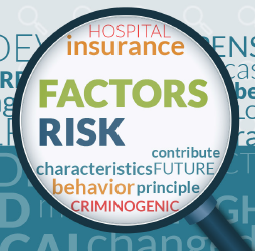In earlier blogs, we discussed some of the advantages of case planning from a risk-reduction perspective. One of the key challenges in operating from a risk perspective is answering a critical question, Where do mental health symptoms fit when working with justice-involved adolescents and adults?
Read MoreMaking Sense of the Interrelationship Between Criminal Risk Domains and Mental Health Symptoms
Posted by Raymond Chip Tafrate, PhD, Damon Mitchell, PhD, & David J. Simourd, PhD on 10/10/19 10:36 PM
Topics: Community Corrections, Evidence Based Practices, Assessment, Risk Principle, Practice Models, responsivity, reentry, high risk client
Risk: A “Four-Letter Word”
Posted by Harris Childers on 5/30/19 10:06 PM
We corrections professionals love to drop the r-bomb. I’m not talking about responsivity, although it is a critical component of EBP that is often neglected if not outright ignored. I’m talking about RISK, that four-letter word that precedes need every time we talk about supervising justice-involved individuals. Assessing criminogenic risk is fundamental to our mission; that’s a given. But what message do we send when we say someone is high risk? Are we poisoning the well, compounding the stigma, and adding barriers to achieving those other coveted “r-words” - rehabilitation, reintegration, and recidivism reduction?
Read MoreTopics: Evidence Based Practices, Risk Principle, responsivity, risk, EBP, Criminal Justice Reform
Intense or "High Intensity"?
Posted by Evan C. Crist, Psy.D. on 9/28/15 9:05 PM
This is the 4th of a 7 part series on The Risk Principle Simplified. Subscribe to our blog and get the series delivered right to your inbox.
What does "High Intensity" mean?
While the principle of matching risk level to treatment intensity level is almost universally accepted, an adequate definition of “intensity” is rarely given. The best definition is offered by Ed Latessa and Christopher Lowenkamp of the University of Cincinnati in their 2004 article titled, “Residential Community Corrections and the Risk Principle: Lessons Learned in Ohio”. The authors believe strongly in quality of treatment and have published several useful articles about its importance, but in this article they lay out a useful definition of intervention “intensity”.
- High intensity intervention equals residential placement and low intensity treatment equals non-residential treatment.
Along with providing, in my opinion, the best definition of “intensity,” this article also provided greater evidence of the importance of matching risk level to intervention intensity. A central finding in the study was:
- When low risk offenders are placed in residential facilities, their rate of reoffending is higher than for low risk offenders who do not receive residential placement.
Topics: Community Corrections, Evidence Based Practices, Risk Principle
The Downside of "Fail First" with High Risk Offenders
Posted by Evan C. Crist, Psy.D. on 4/16/15 12:22 PM
This is the 7th of a 7 part series on The Risk Principle Simplified. Subscribe to our blog and get the next series delivered right to your inbox.
Allowing High Risk Offenders to "Fail First"
While the danger of over-intervening with low risk offenders is generally acknowledged and respected, there is a trend toward policy makers ignoring the opposite side of the coin. For a variety of political and financial reasons, high risk offenders are receiving low intensity interventions under a “fail first model”. Instead of matching intensity of the intervention to the assessed risk level, high risk offenders are being provided low intensity interventions with the idea that when they fail, they will be provided a higher level of supervision. This policy has negative consequences for the following stakeholders: Victims, Offenders and The EBP Movement.
Read MoreTopics: Community Corrections, Evidence Based Practices, Risk Principle
Treating Very High Risk Clients can be Something Else Altogether
Posted by Evan C. Crist, Psy.D. on 4/9/15 12:13 PM
This is the 6th of a 7 part series on The Risk Principle Simplified. Subscribe to our blog and get the series delivered right to your inbox.
What factors contribute to risk?
Just like the insurance industry, the risk model for offenders has very specific factors to consider. These models were developed in the exact same way that life insurance risk levels are determined. The life insurance industry looks at factors that correlate with early death. The criminal risk model looks at factors that correlate with future criminal behavior. Similarly, some of these factors can be changed (“dynamic risk factors” or “needs”) and others are static. Our next white paper, The Need Principle Simplified, will address “The Key 3” and how various offender situational and personal characteristics interact to increase or decrease criminogenic risk.
When High Risk is Too High: The Psychopath
Imagine what you would be capable of if you were completely self-interested and did not experience fear or guilt. While it is tough to even imagine,
Read MoreTopics: Community Corrections, Evidence Based Practices, Risk Principle
Subscribe To Our Blog
Recent Posts
Posts by Topic
- Community Corrections (61)
- Evidence Based Practices (44)
- Community Corrections Professional (23)
- Software (15)
- Practices (12)
- Change (11)
- Technology (10)
- Risk Principle (8)
- reentry (8)
- probation staff (7)
- EBP (6)
- Outcomes (6)
- client development (6)
- client needs and values (6)
- coaching community corrections clients (6)
- Assessment (5)
- Community (5)
- Developing a practice model (5)
- Justice-Involved Clients (5)
- Remote work (5)
- The Coaching Habit (5)
- parole (5)
- risk (5)
- tele-supervision (5)
- tele-work (5)
- Community Engagement (4)
- Evan C. Crist (4)
- Community Corrections Client Services (3)
- Criminal Justice Reform (3)
- Implementation (3)
- Listening Skills (3)
- Motivational Interviewing (3)
- Policy (3)
- Positive Reinforcement (3)
- Practice Models (3)
- high risk client (3)
- reaching clients emotions (3)
- responsivity (3)
- Addiction (2)
- BOP (2)
- Conferences (2)
- ICCA (2)
- Management (2)
- Michael Bungay Stanier (2)
- Relapse Prevention (2)
- halfway house (2)
- jic (2)
- principles (2)
- procedures (2)
- program results (2)
- APPA (1)
- Appreciative Thinking (1)
- Brian Lovins (1)
- COVID-10 (1)
- Community Connection (1)
- Coronavirus (1)
- Crisis (1)
- Customer Service (1)
- Data Management (1)
- Fidelity (1)
- ICCA Seattle (1)
- Juvenile Corrections (1)
- Leadership (1)
- Monitor History (1)
- Opioid Addiction (1)
- Opioid Crisis (1)
- Orange is the New Black (1)
- Program Data (1)
- Reforms (1)
- Relapse (1)
- Second Chances (1)
- Switch by the Heath Brothers (1)
- Treatment (1)
- drug testing (1)
- going paperless (1)
- govcio outlook (1)
- impact sessions (1)
- innovation (1)
- intrinsic motivation (1)
- justice reinvestment (1)
- marijuana testing (1)
- money savings (1)
- opiod testing (1)
- paperless office (1)
- purpose (1)
- remote working (1)
- resources (1)
- sanction (1)
- staff productivity (1)
- technology solutions provider (1)
- the awe question (1)
- what works (1)
- what's on your heart (1)
- work from home (1)






